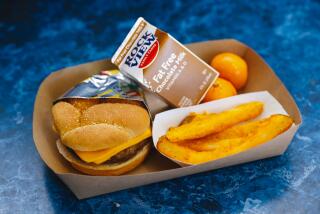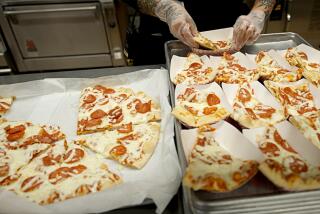Adding Creativity to Bag Lunches : Balance the Meal With a Variety of Nutritious Foods
- Share via
The age-old question that has plagued parents for years is always asked this time of year--what can I pack for the children’s school lunch? Well, there’s more to brown bag lunches than a sandwich.
Brown bag lunches needn’t be the chore that many parents make them out to be, according to Jane Rubey, registered dietitian, a consulting nutritionist with the Dairy Council of California in the San Francisco Bay area. She recommends including children in the planning and preparation of lunches packed at home. “If they help select the food, they are more likely to eat it,” she said.
Rubey suggests buying foods high in nutrient value and limiting foods and snacks that are high in sugar, salt and fat.
Too Many Calories
“Many kids are overnourished with calories and undernourished with nutrients,” Rubey said.
“Balance the lunch with a variety of foods that include milk, meat, vegetables and fruits, and whole-grain breads and cereals,” Rubey advises.
Rubey said sandwiches are a good choice for lunch, especially if made with whole-grain bread and a nutritious filling, like meat, cheese, tuna salad, or peanut butter.
She encourages creativity when packing a school lunch. “Leftovers make great lunches--a piece of chicken, a slice of pizza or quiche, accompanied by a piece of fruit, or fresh raw vegetables like carrots or celery sticks.”
Rubey suggested muffins as an alternative to a sweet dessert. “They are like a cupcake, but far more nutritious. And you can make a variety of muffins from the same basic recipe.”
Food Safety in Mind
Rubey advised parents to keep food safety in mind when packing school lunches. Use a thermos or insulated container to keep foods like milk or yogurt cold and foods like soup or chili hot.
Freezing lunch the night before will help keep foods cold until lunchtime. Sandwiches, casseroles, meats, cheese and poultry freeze well. Avoid freezing mayonnaise and foods with high moisture content, like tomatoes and celery, which lose texture and flavor after freezing.
Remember that young children have small appetites. A whole sandwich may be too much food, so cut sandwiches, fruit and other items into small, easy-to-handle amounts.
By helping with grocery shopping and preparation of their school lunch, children can learn the importance of eating well-balanced, nutritious meals, and take over the task of packing their own lunch as they grow older.
More to Read
Eat your way across L.A.
Get our weekly Tasting Notes newsletter for reviews, news and more.
You may occasionally receive promotional content from the Los Angeles Times.










